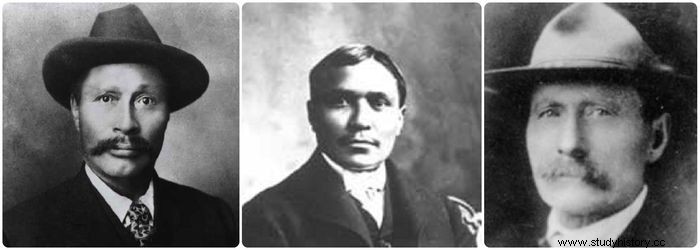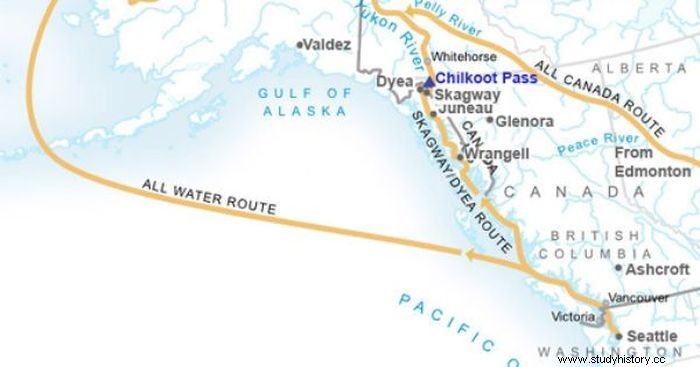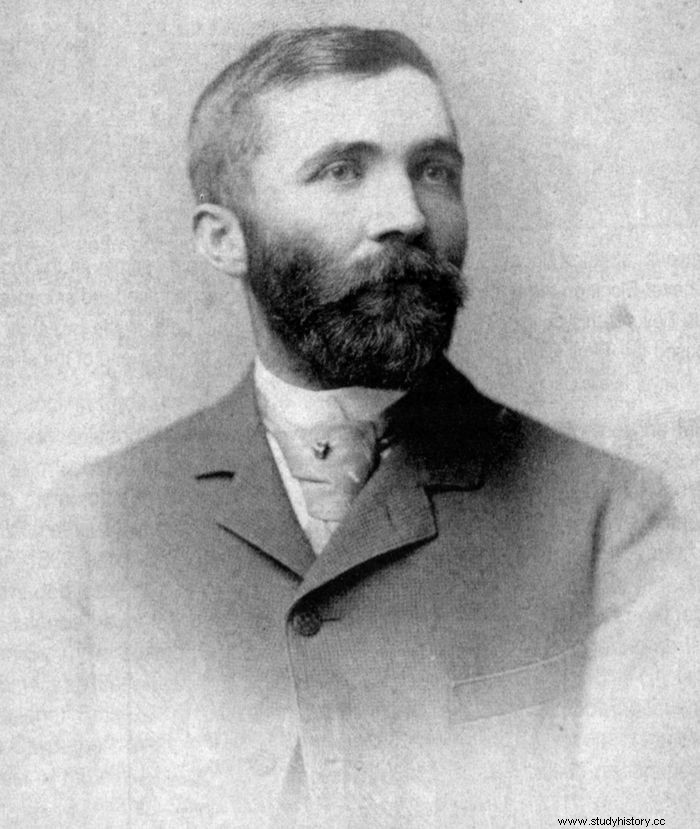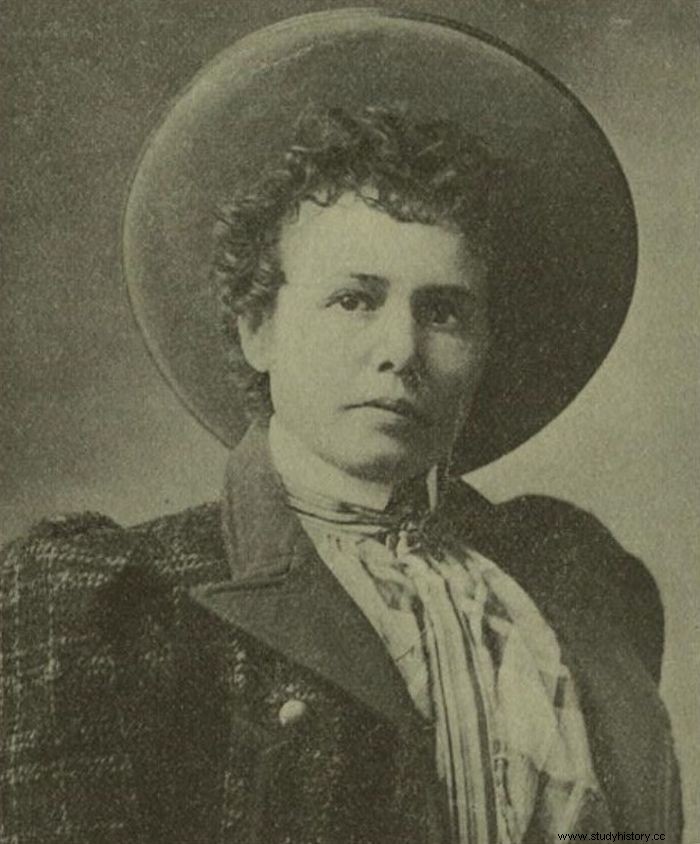During the Klondike Gold Rush, between 1896 and 1899, about 100,000 XNUMX people moved to the Klondike area of northwestern Canada in the Yukon to search for gold. It is also known as the Alaska Gold Rush, the Yukon Gold Rush and the recent great gold rush.
In 1896, gold was discovered in many rich places along the Klondike River. But because the area was so far away and the winters were so cold, word of the gold could not reach the rest of the world until the following year. Nevertheless, newspaper articles about gold caused panic across the country, and many quit their jobs and went to Klondike to look for gold.
It took gold rushers a year to get to Klondike because the country was rough and the weather was even worse. Together with extreme cold and frequent snowstorms, the long climb over mountainous terrain and frozen rivers gave a long and arduous journey. The Canadian authorities told each prospector that they would need at least enough food for one year to avoid starvation.
Klondike Gold Discovery

George Carmack, an American prospector in northwestern Canada near the Alaska border, found gold on August 16, 1896. His Tagus wife Kate (Shaaw Tláa), brother-in-law Shookum Jim (Keish) and their nephew Dawson Charlie (Káa Goox)) were with him . Canadian prospector Robert Henderson suggested that George hunt for gold on Bonanza Creek (called Rabbit Creek at the time).
Unknown whether Carmack or Shookum Jim first discovered the gold. Fearing that the authorities would not recognize an indigenous claimant, the group let George Carmack be the official discoverer. However, there was plenty of gold throughout the river and its tributaries, regardless of who found it first. Carmack claimed four strips of land by the riverbank he could legally extract. These were for himself, Jim and Charlie. As soon as the claim was registered the day after the discovery, the rumor quickly spread to nearby mining camps in the Yukon River Valley. By August, local miners had claimed the entire Bonanza Creek. Eldorado Creek, which fed Bonanza, had additional gold. This source of gold is richer than Bonanzas. The gold rush grew as miners and speculators sold demands at high prices.
Before Christmas, the message reached Circle City, the largest gold mining town on the Yukon River, 50 miles south of the Arctic Circle. Many prospectors went for Klondike on dog sleds despite harsh winter conditions. They hoped to come before the best claims happened. Despite the excitement among Klondike's miners and prospectors, the outside world was ignorant. Canadian officials reported the discovery and influx of prospectors to Ottawa, but the government paid little attention. Frozen rivers hindered knowledge of the gold finds by hindering transportation. The first boats to bring newly extracted gold and the entire history of the finds left the area in June 1897.
1897 Klondike Gold Rush stamped

The first prospectors to return from Klondike landed in the United States on July 15, 1897. They first went to San Francisco, and two days later they made their way to Seattle. According to press reports at the time, the ships Excelsior and Portland had arrived with an estimated 1,139,000 dollars in gold, equivalent to one billion dollars with today's values. But later it was discovered that this sum was significantly underestimated.
As a direct result, a storm developed in the Yukon River Valley. It is believed that 100,000 30,000 individuals took the journey to the Klondike in search of the legendary gold, but only 40,000 1897 to 1898 XNUMX were successful in their quest. From summer XNUMX to summer XNUMX, this period is considered the height of the gold rush in the Klondike. Despite this, the movement of prospectors attracted much attention, and as a result, outfitters, reporters and photographers also took the journey.
Routes taken

Stampeders had many Klondike trails. Some chose the "rich man's way," easy but expensive:sailing around Alaska and up the Yukon, while others stomped trying to cross land over the often twisted mess. Some of these routes took an extra year, while others tried to cross the glaciers Yakutat and Valdez. Many individuals disappeared or went blind in the ice towers. Most stompers chose White Pass and Chilkoot Trails. Finally, a "poor man" stomped up the Inner Passage. They unloaded and crossed the Coast Range to the Yukon. Stampeders hiked 310 miles by river on a handmade canoe to the gold fields.
Ships brought gold hunters to Skagway and Dyea, Alaska, in 1897-98. Both spread from tents to settlements, and the construction of two-mile docks took place on Tlingit fishing beaches. William Moore created the Skagway on the White Pass Trail. His modest estate had occupied 10,000 1897 temporary residents who were trying to carry a year's equipment and supplies across the coastal area and down the Yukon River. Dyea, thirty miles away at the tip of Taiya Inlet, had the same busy city as gold diggers heading north. The Chilkoot Trail was the most difficult for men since herd animals could not travel the steep slopes. Before 1898 and 3,000 stompers carried everything on their backs. Prospectors overloaded and beat their herd animals on the White Pass Trail to the dead. Many of the XNUMX animals that died on this trail were buried in Dead Horse Gulch.
From the tide to the lakes it was only 35 miles, but each person walked hundreds of miles along the trails and moved things. Once the prospectors had brought their goods to the lakes, they designed or purchased boats to float the remaining 560 miles down to Dawson City and the Klondike mine area.
Costs and Mining Results
Dawson City, established in 1896, had over 40,000 4,000 inhabitants during the Klondike Gold Rush. Fifteen thousand inhabitants became prospectors. Only 1898 struck gold, and few became rich. In XNUMX, most stompers had occupied the main power stations. Many stompers did not realize when they traveled to the Klondike that mining takes time and money.
The mines needed clearing, and the burning of wood by chance thawed the mines. This can cost $ 1,500 (around $ 42,000 28,000). A dam costs $ 1,500, ditches $ 16,800, and lock boxes up to $ 4,600. An initial investment of $ 128,000 will be $ 15 today. Investment proved to be worthwhile for many prospectors. After finding gold, Klondike streams were 29 times richer in gold than streams in California. For example, in the first two years of Klondike exploration, claims 230,000 on Eldorado Creek generated $ 6,440,000 ($ XNUMX) in gold.
Klondikers could only look for gold after obtaining a mining license in Dawson or on their way from Victoria. Then they can claim mining rights. Prospectors made demands by driving a bet at a certain distance and returning to Dawson to register them. Licenses and claims cost money, and they received one permit for only one claim per person in three days. Married couples can file a claim for the wife, and double their land.
After one year, claims demanded an annual fee of $ 100 ($ 2,800). Any prospector who left a claim for more than three days risked another miner claiming it. In addition, the Canadian government introduced a royalty of 10 to 20% of the gold value of a claim.
The impact of the Klondike Gold Rush
If everyone who participated in the gold rush got an equal share of the nearly $ 29 million in gold discoveries during the exciting years of 1897 to 1899, it would not even be close to what they had spent time and money getting to. Klondike. The economy on the continent, on the other hand, was in a depression and had many unemployed. So spending during the gold rush helped the continent's economy.
The Klondike gold rush led to rapid growth in the Yukon Territory, which was officially made June 13, 1898, when Parliament passed a law making it a territory. The gold rush left a system of supply, support and government that allowed the area to continue to grow. If gold had not been discovered, this area would have grown slowly.
The people who lived before the gold rush were thrown into chaos and lost their rights. The most enduring thing about the Klondike gold rush is how it got people thinking about it. It was a common experience that everyone, rich or poor, went through on a fairly smooth path. It left an indelible mark on their memories.
Klondike Gold Rush King - Anton Stander
Anton Stander and Violet Raymond became wealthy by betting early claims along Bonanza and Eldorado. Most "Klondike Kings" exemplified stampede ideals with rags to riches, and Anton Stander was among them. Stander moved to New York with $ 1.75. He left the Yukon as Klondike's fourth richest man.
Born in Austria in 1867, Stander worked as a cowboy, coal miner, shepherd and waiter in America. He sold everything and moved north in the spring of 1896, or "drifted towards the Yukon area," as one newspaper put it. He made the discovery with four friends on the Yukon River. They ran to Bonanza Creek, but it was blocked. So Stander claimed "Bonanza's puppy," afterwards called Eldorado Creek. Klondike's richest river!
Stander lived until 1899, when Violet Raymond, a dancing girl from Dawson, moved into his cabin on Eldorado Creek, whose chimney still stands on Klondike Gold's land. Stander bought Violet most of Dawson's diamonds and jewels, and the power couple got married and honeymooned in Paris, Japan and China. They bought Seattle's historic Holyoke building and built the 250-room Stander Hotel, one of America's best west of NYC.
Stander liked alcohol, which led to his jealousy, and ended the marriage in 1906 and saw their divorce. Stander went north to prospect. He died in distress in 1952 at the Pioneers' Home in Sitka, Alaska, erected by another Klondike magnate for explorers.
Klondike Gold Rush King - Clarence Berry (CJ)

CJ Berry sold everything to pursue his fortune in the north. Only Berry and two others reached the Chilkoot Pass in 1894. Berry died rich and built a business empire from his gold rush money. The success was not immediate. Berry spent two months eating beans during the northern winter of 1894-95. Berry learned to deal with the challenging conditions of the nearby First Nations. In 1895 he returned to California and married his boyfriend. George Carmack paid Berry in Forty Mile with gold nuggets in August 1896. Berry set course for Rabbit Creek and made demands.
The creation of Berry's riches happened when he met Anton Stander in a Forty Mile taverna. Both guys filled up, but Stander was short of cash, so Berry pondered him, and Stander swapped half the Eldorado claim with half Berry's Bonanza claim. Berry and two of his brothers ran the Eldorado claim. Berry and Stander bought two adjacent shares and divided the land. CJ and Ethel Berry returned to America at Portland on July 17, 1897.
Berry was sober, hardworking and ambitious in a camp where other prospectors drank, slept and sang. He placed gold nuggets and liquor at the entrance to the Eldorado cabin that passers-by could take with them. Berry and his brothers beat it back in Alaska before returning to California to obtain oil fields. Hans CJ Dredging Co. used steam to melt permafrost in Alaska. Berry Petroleum Corp. traded on Nasdaq as BRY. The CJ Berry Foundation supports arts, health, education and conservation.
Klondike Gold Rush Trickster - Jefferson "Soapy" Smith

Before arriving in the Klondike, Jefferson Randolph (Soapy) Smith II was a deceiver and criminal lord. He led the "premium package soap racket" for 20 years before expanding to salons, arcades, auction shops and elections. Soap scams involve selling pieces of soap on a street corner, wrapping $ 1 to $ 100 in cash in some, and then covering them all with plain paper. Smith's henchmen would be the only "winners"; he would declare the $ 100 bar of soap unclaimed and auction off the others to the highest bidder before fleeing.
Soapy became Denver's most powerful criminal leader by acquiring political influence. Soapy saw an opportunity when the Klondike fever spread. He moved to Seattle and casually said he wanted to run Skagway. He later moved to the port city of Alaska and began working.
Soapy's crews stole money and gold. His men disguised as pastors and reporters in Skagway and on ships to find out who had the money. They used theft, rigged card and poker games and other schemes. Soapy built a fake telegraph office in 1898, but the lines did not go far. Soap from families who gave and received "messages", Soapy built a salon known as "the actual town hall" and hired Skagway's deputy US Marshal to avoid imprisonment. Soapy's critics established a vigilant group, but the scammer was the grand marshal of Skagway's 1898 Independence Day parade. Four days later, he was shot at Juneau Pier.
Klondike Gold Rush Entrepreneur - Belinda Mulrooney

Most Klondike reports barely mention women since they could not vote. For example, Pierre Berton's Klondike:The Last Great Gold Rush, 1896-1899 Kate Carmack says only twice. However, a Klondike lady fought against barriers to succeed in his community. Belinda Mulrooney used her cleverness and perseverance to become as wealthy and prominent as the Klondike Kings in her 20s, and she did so without panning or digging. Instead, "the sharp-edged Irish immigrant" broke out the miners "and became a specialist in Klondike-style supply and demand.
Mulrooney got tired of the traditional roles women played in America. In 1893, the 20-year-old visited Chicago's Columbian Exposition to see electricity. Mulrooney managed a cafe at the entrance and earned $ 8,000. She took orders for women's products from San Francisco to Alaska and heard about the Bonanza strike. In the spring of 1897, Mulrooney found Dawson. At Chilkoot Pass, she bought supplies from tired stompers.
Mulrooney carried long, curious tin cans north. Dusty, grimy Dawson women grabbed clean skirts, silk nightgowns and lingerie. She also opened eateries with more than bacon, beans, bread and clean hotels. Mulrooney made a fortune selling food, drinks and rooms to hungry, thirsty, weary prospectors at her Grand Forks and Dawson hotels. The motels helped her gather potential information. In 1901, Mulrooney married "Count Charles Eugene Carbonneau", a French deceiver who pretended to be an aristocrat. They divorced in 1906 after traveling the world, and Mulrooney built Carbonneau Castle in Yakima, Washington, in 1908. She died at a 95-year-old nursing home.
Trump's wealth from the Klondike Gold Rush
A young German guy named Freidrich Trump moved to America a century before Donald J. Trump's presidency. Freidrich, 16, left before reaching conscription age in 1885. He took a steamboat to New York and lived with his sister and her hairdresser. Too ambitious to cut long hair.
In 1891 he moved to Seattle and renamed a restaurant. The Seattle restaurant advertised "Rooms for Ladies", a euphemism for prostitution, and Trump used the same strategy when he joined the Klondike Gold Rush. Young Trump's first outing to real estate was in the state of Washington before the Yukon. Trump established a mineral claim in Monte Cristo and built a hotel on property he did not own. Monte Cristo failed, but Trump had moved back to Seattle before Portland arrived with his wealth.
In May 1898, Trump founded the Arctic Restaurant and Hotel in Bennett, a frontier settlement on the Skagway-Klondike road. He earned a fortune by feeding stompers with food, drink and women. The new train from Skagway to Whitehorse went over Bennett, so Fred Trump moved Whitehorse's restaurant and inn. Trump stuck with food, drink, ladies and gambling. So, after an argument with his business partner and ahead of a prostitution spree, Trump transferred his Yukon money to Germany before returning to the United States.
The conclusion
In 1898, many Dawson City prospectors could not earn a living and fled. Random wages dropped to $ 100 a month for those who stayed. Worse, global publications opposed the Klondike gold boom. Finally, in 1898, the Spanish-American War replaced the Klondike. Dawson City's loss of its wild and lawless charm led to a downturn in the gold rush. As a result, the city became conservative and gloomy. Even the gravel and mud streets that gave Dawson its boundary aspect were paved.
Gold discoveries in Canada and Alaska gave the ultimate blow. Gold was discovered near Lake Atlin on the Yukon River in August 1898. The discovery of more significant quantities in Nome, the Yukon, occurred in 1898–99, and the Klondike gold rush was completed in 1899.
